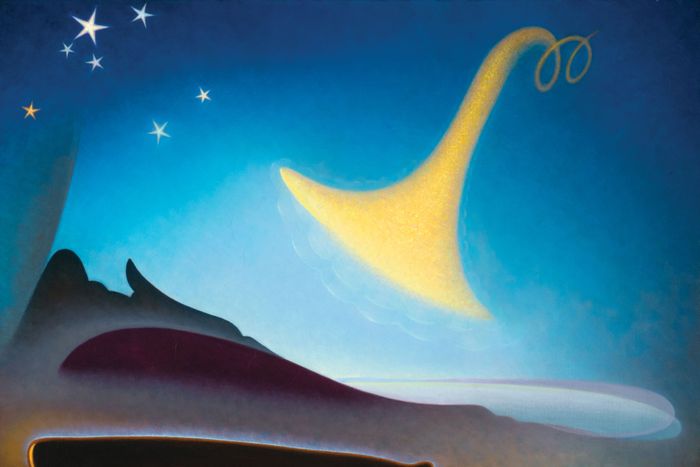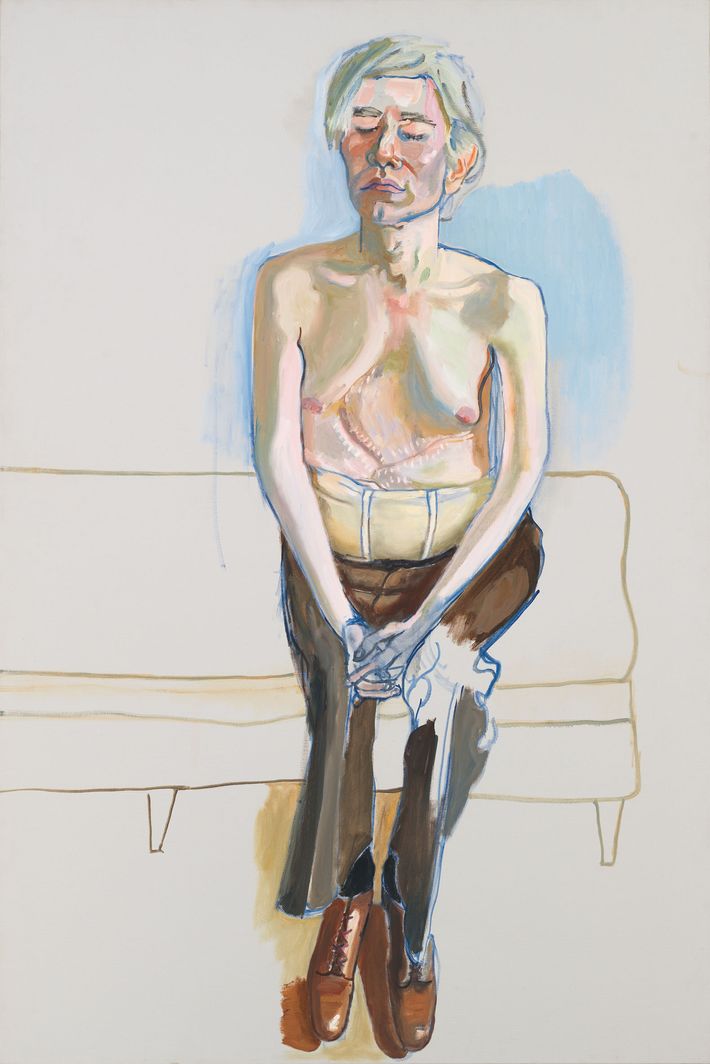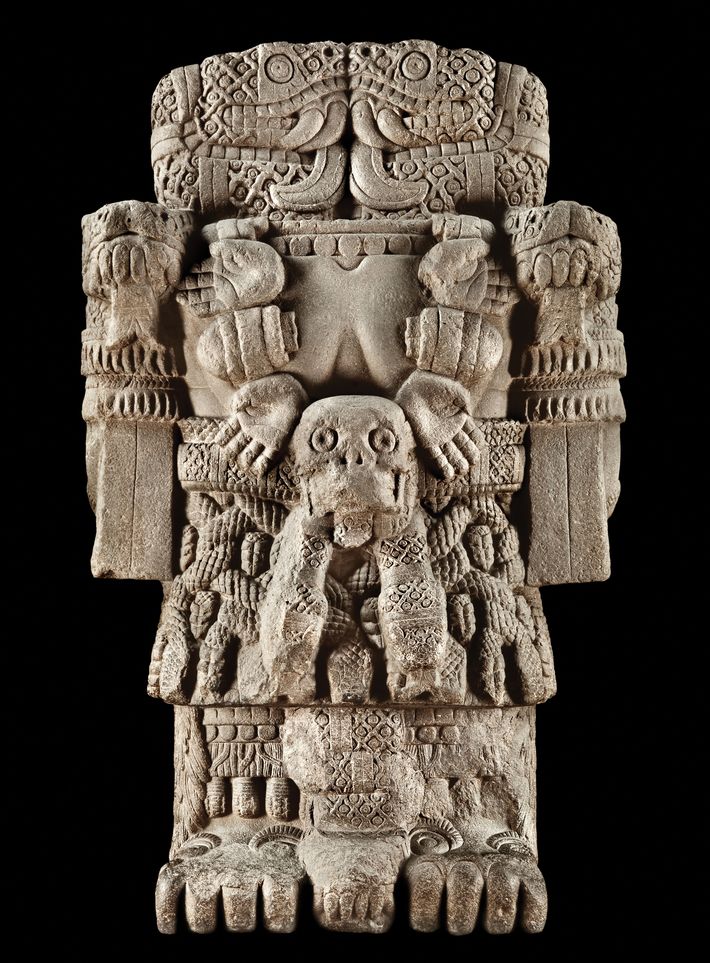For a new book, It Speaks to Me, Jori Finkel asked 50 artists to discuss an artwork they find inspiring. Not their favorite artwork of all time, housed anywhere, but something from a local museum. What might they take a friend visiting from out of town to see? In many cases, the stories the artists tell are partly autobiographical, revealing why they thought to become an artist or pointing to why they make a certain kind of work. And several women in the book chose to champion female┬áartists or feminist themes. ÔÇ£IÔÇÖve always been interested in how artists rewrite art history, not just through their own contributions but also by recognizing or embracing other artists who came before,ÔÇØ Finkel says. ÔÇ£You can see that in these interviews ÔÇö they remind us that women give birth to women in more than one way.ÔÇØ
1. Judy Chicago on Agnes Pelton (pictured above)
ÔÇ£Whenever I see an Agnes Pelton painting, I feel drawn to its mystery and luminosity. I always feel there is some deep symbolic meaning, but what that is isnÔÇÖt always clear. Pelton was part of the Transcendental Painting Group of New Mexico, a short-lived group of painters in the 1930s and ÔÇÖ40s who, influenced by Cubism and the Bauhaus, were primarily abstract. A peer of Georgia OÔÇÖKeeffe, she was also brought to New Mexico by the great eccentric arts patron Mabel Dodge Luhan. I see a certain affinity between their work in the way they use color and form to convey an internal reality. My reading of this painting is that itÔÇÖs a dreamlike scene: an abstracted landscape with both night and day present simultaneously. Stars appear in the dark sky to the left, while the small body of water is under the light sky to the right. The form in the sky has been described as a golden trumpet, but thatÔÇÖs not how I read it. If you look closely, underneath that shape and also on top of it is a faint texture that makes it feel like itÔÇÖs moving, spinning into a lighter sky. For me, that form ascending into the sky and spinning away from the landscape is a luminous symbol of death. Agnes PeltonÔÇÖs father died when she was 10 years old. My father died when I was 13, and I also dealt with his death in abstract painting. If you rotate the painting to the left so that itÔÇÖs vertical, the mountain turns into what looks like a silhouette. The museum reads it as her fatherÔÇÖs face, but I think thatÔÇÖs bizarre and literal. Women like OÔÇÖKeeffe and Pelton used abstraction to convey personal meaning, as opposed to just dripping paint on canvas or making circles like Ellsworth Kelly. One of my theories is that until the advent of abstraction, women artists were not free to convey their experiences directly. Abstraction opened up the visual landscape for us to invent forms to convey our internal reality.ÔÇØ
2. Shirin Neshat on Alice Neel
ÔÇ£Making a portrait of a celebrity who has been photographed or painted a million times can be very challenging. How can you go beyond the persona to capture their true character and convey something new and not redundant? How do you go beyond the constructed image to reveal the vulnerability and humanity of who they are? Alice Neel does this so brilliantly and simply in this painting of Andy Warhol, getting under the skin of this powerful artist. She actually shows us his scars. You can see his scar from being shot by Valerie Solanas, and the medical corset he wore afterward. You see his breasts, which are exaggerated to look very feminine. I think asking him to take of his shirt was an incredible move, and I still canÔÇÖt believe he agreed to it. ItÔÇÖs hard to think of an artist who controlled his image more carefully than Warhol. He always wore a wig; he was a socialite but at the same time very antisocial, very cool. And it was devastating for him to be seen naked. So this painting really goes against type. ItÔÇÖs the only portrait of Warhol I can recall where he lets go of all of these shields. I also love the unfinished quality of the painting. At the bottom, his shoes are glossy and shiny, like he was dressed to go out, but as you look up, a lot of the painting looks unfinished. The light-blue color behind Warhol could be the beginning of some backgroundÔÇöyou would think Neel was going to paint the whole background blue and fill in the couch, but she stopped right there. I think she was trying to capture the spirit of her subjects, and the minute she did that, she would stop. ItÔÇÖs one of the most powerful things about this painting, how minimal and simple it is. ItÔÇÖs a tremendous lesson for those of us obsessed with the human portrait as a powerful vehicle for communication. For my feature film, Looking for Oum Kulthum, I spent six years thinking about how to make a narrative to get under the skin of this iconic singer loved by millions of people in the world. I couldnÔÇÖt do it in the end. Instead, I made a film about a filmmaker trying to make a portrait, a biopic, of this woman nobody could really know.ÔÇØ
3. Pia Camil on an Aztec Statue
ÔÇ£Coatlicue is an earth goddess, like the goddess of all goddesses in Aztec culture. The most popular variation of the legend goes that she is the mother of Huitzilopochtli, the sun god, and became pregnant with him through a miracle. SheÔÇÖs sweeping the floor of a temple, doing penance of some sort, when a ball of feathers falls on her lap, impregnating her. At this point, her daughter Coyolxauhqui seeks revenge on her mother for getting pregnant. She and her siblings are about to behead their mother when Huitzilopochtli is miraculously born, in full armor, just in time to save her. He kills and dismembers Coyolxauhqui, sending her head into the sky to become the moon. He eventually represents the sun. So you see in this large statue a beautiful image of a woman with two serpents for a head and two serpents as arms. She wears a skirt made of serpents, which is what coatlicue means. She also has an amazing necklace that represents life, a chain of hearts and hands, while her belt is fastened by a skull. To me whatÔÇÖs striking is how the sculpture combines beauty and darkness, or birth and death. IÔÇÖve seen the sculpture at various points in my life, but when I was pregnant with my second daughter I was really struck by its powerÔÇöI felt the entire power of femininity, the monstrosity of maternity, was with me. And the history of this sculpture is a history of Europeans being unable to deal with this power. The Coatlicue statue was found buried near what is now the Z├│calo in Mexico City on August 13, 1790, just a few months before the Aztec Sun Stone was found. So the Spaniards then seized on the Sun Stone as proof that they had not conquered a barbaric culture, as many thought, but a very advanced civilization with knowledge of math and astronomy. They soon put it up in full view on the outside of Mexico CityÔÇÖs biggest cathedral. It was the opposite with Coatlicue. They found the figure so monstrous and powerful that they essentially hid her away in a remote courtyard of a university. And when indigenous people and mestizos found her anyway and started worshipping her and bringing her flowers, the Spaniards buried her again. ItÔÇÖs such an interesting metaphor for male versus female knowledge.ÔÇØ
*A version of this article appears in the May 27, 2019, issue of New York Magazine. Subscribe Now!




